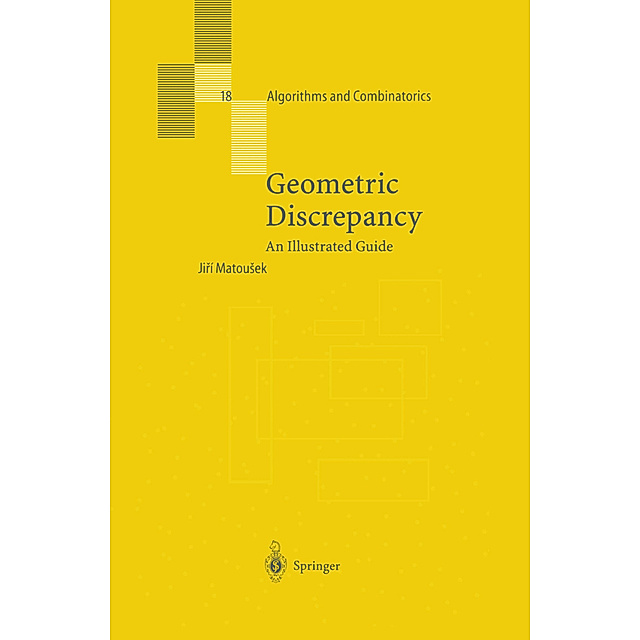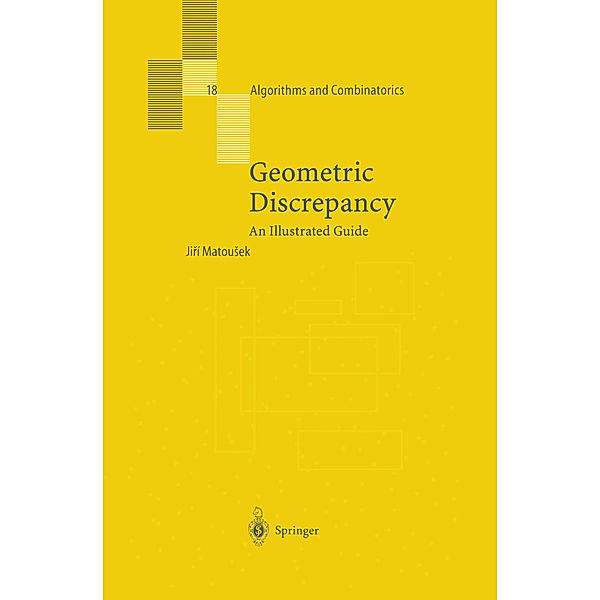Geometric Discrepancy
An Illustrated Guide
(Sprache: Englisch)
What is the "most uniform" way of distributing n points in the unit square? How big is the "irregularity" necessarily present in any such distribution? This book is an accessible and lively introduction to the area of geometric discrepancy theory.
Voraussichtlich lieferbar in 3 Tag(en)
versandkostenfrei
Buch (Kartoniert)
164.99 €
- Lastschrift, Kreditkarte, Paypal, Rechnung
- Kostenlose Rücksendung
- Ratenzahlung möglich
Produktdetails
Produktinformationen zu „Geometric Discrepancy “
What is the "most uniform" way of distributing n points in the unit square? How big is the "irregularity" necessarily present in any such distribution? This book is an accessible and lively introduction to the area of geometric discrepancy theory.
Klappentext zu „Geometric Discrepancy “
Discrepancy theory is also called the theory of irregularities of distribution. Here are some typical questions: What is the "most uniform" way of dis tributing n points in the unit square? How big is the "irregularity" necessarily present in any such distribution? For a precise formulation of these questions, we must quantify the irregularity of a given distribution, and discrepancy is a numerical parameter of a point set serving this purpose. Such questions were first tackled in the thirties, with a motivation com ing from number theory. A more or less satisfactory solution of the basic discrepancy problem in the plane was completed in the late sixties, and the analogous higher-dimensional problem is far from solved even today. In the meantime, discrepancy theory blossomed into a field of remarkable breadth and diversity. There are subfields closely connected to the original number theoretic roots of discrepancy theory, areas related to Ramsey theory and to hypergraphs, and also results supporting eminently practical methods and algorithms for numerical integration and similar tasks. The applications in clude financial calculations, computer graphics, and computational physics, just to name a few. This book is an introductory textbook on discrepancy theory. It should be accessible to early graduate students of mathematics or theoretical computer science. At the same time, about half of the book consists of material that up until now was only available in original research papers or in various surveys.
What is the "most uniform" way of distributing n points in the unit square? How big is the "irregularity" necessarily present in any such distribution? Such questions are treated in geometric discrepancy theory. The book is an accessible and lively introduction to this area, with numerous exercises and illustrations. In separate, more specialized parts, it also provides a comprehensive guide to recent research. Including a wide variety of mathematical techniques (from harmonic analysis, combinatorics, algebra etc.) in action on non-trivial examples, the book is suitable for a "special topic" course for early graduates in mathematics and computer science. Besides professional mathematicians, it will be of interest to specialists in fields where a large collection of objects should be "uniformly" represented by a smaller sample (such as high-dimensional numerical integration in computational physics or financial mathematics, efficient divide-and-conquer algorithms in computer science, etc.).
Inhaltsverzeichnis zu „Geometric Discrepancy “
1. Introduction.- 2. Low-Discrepancy Sets for Axis-Parallel Boxes.- 3. Upper Bounds in the Lebesgue-Measure Setting.- 4. Combinatorial Discrepancy.- 5. VC-Dimension and Discrepancy.- 6. Lower Bounds.- 7. More Lower Bounds and the Fourier Transform.- A. Tables of Selected Discrepancy Bounds.- Hints.
Bibliographische Angaben
- Autor: Jiri Matousek
- 2009, 1999, XI, 289 Seiten, Maße: 15,5 x 23,5 cm, Kartoniert (TB), Englisch
- Herausgegeben: Jiri Matousek
- Verlag: Springer, Berlin
- ISBN-10: 3642039413
- ISBN-13: 9783642039416
- Erscheinungsdatum: 15.12.2009
Sprache:
Englisch
Rezension zu „Geometric Discrepancy “
From the reviews:"The book gives a very useful introduction to geometric discrepancy theory. The style is quite informal and lively which makes the book easily readable." (Robert F. Tichy, Zentralblatt MATH, Vol. 1197, 2010)
Pressezitat
From the reviews:"The book gives a very useful introduction to geometric discrepancy theory. The style is quite informal and lively which makes the book easily readable." (Robert F. Tichy, Zentralblatt MATH, Vol. 1197, 2010)
Kommentar zu "Geometric Discrepancy"





Schreiben Sie einen Kommentar zu "Geometric Discrepancy".
Kommentar verfassen